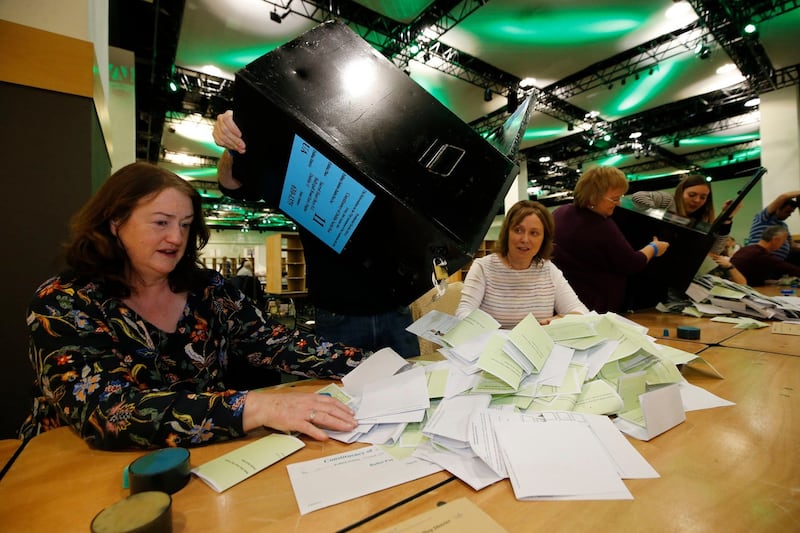The dismal performance of Sinn Féin in the presidential election represents a blow for Sinn Féin and for Mary Lou McDonald’s leadership. The party wanted to broaden its brand and promote its United Ireland message. It failed, and it got its strategy badly wrong.
In the end, its candidate Liadh Ní Riada secured only 6.38 per cent of the vote. It was sub-par, comparable to Fine Gael’s Gay Mitchell’s result in the election seven years ago. In that 2011 election the late Martin McGuinness (himself bruised by the campaign) attracted 13.72 per cent of the vote.
So Sinn Féin found its support more than halved from the last election, and nowhere near its natural level of support.

If Peter Casey had not shot up from nowhere to second place, the Sinn Féin performance would have been the story of the election.
It represents the first big electoral failure for McDonald, who is attempting to make the party more forward-facing after the long Gerry Adams era.
Over the weekend, McDonald defended the party’s decision to run a candidate, saying it was important that the role of head of State should be contested. She also said parties had to be brave and take risks, even if it led to failure. “You cannot run a party through a rear view mirror,” she said.
That said, the view in the rear view mirror is not good.
A number of reasons emerge for the failure, some within the control of the party and some outside its control.
They included Ní Riada’s low profile and lack of name recognition; her self-confessed “naive” questioning of the HPV vaccine on Facebook in 2016; her unimpressive efforts to explain her take-home MEP’s salary; her comments on her willingness to wear the poppy if elected president, and the decoupling of the Sinn Féin brand from the candidate.
There were also over-arching factors. For one, there was a popular incumbent. Secondly, in these types of personality contests, the field is invariably whittled down to two as the campaign nears its final moments.
It happened with Higgins and Seán Gallagher in 2011. Now, once Casey started gaining traction with his comments on Travellers, the others lost their footing quickly as he gained support.
National recognition
A majority of Sinn Féin supporters voted for either Higgins or Casey. It was clear they saw it as a contest between those two. On top of that, a proportion of Sinn Féin voters did not care about this election and did not bother voting.
Sinn Féin’s first mistake was choosing Ní Riada so late, on September 16th, with barely a month to go until the election.
Rewind back to 1990 and look at the case of Mary Robinson. Her national recognition was low, so she began campaigning in March, seven months before polling day, visiting every part of the country.
Ní Riada had potential. She is an effective MEP and ticked all the boxes as a modern Sinn Féin candidate. She has no baggage from the Troubles, has a dynamic personality and is a native Irish speaker. She also represents the liberal and feminist image the party projects under McDonald.
But she was unknown. Everybody knew McGuinness in 2011. Outside her own constituency, Ní Riada was hardly a household name. When The Irish Times joined her on a canvass in Dublin, even those who wished to vote for her could not get their tongues around her name. A month was hardly enough.
It was hard then to understand the party’s strategy of effectively going off the radar for two weeks, bringing her on a tour of the country. She was not as present in the national media as others.
Her core message was starting a conversation about a united Ireland. She also went to Belfast, presumably because of the party’s 32-county philosophy, but certainly not gaining her any extra votes.
That was lost in the messy debates involving six candidates. She also ran into headwinds on her refusal to describe any IRA act as “terrorism” and her claim her take-home pay was equivalent to the average national wage (it was much higher than that).
Sinn Féin’s own supporters did not buy into the election. They did not see it as a Sinn Féin event. Its Tallaght-based TD Seán Crowe found it hard to drum up enthusiasm among canvassers. “It was very hard to get people knocking on the doors. We did not have huge numbers. We were depending on the debates but they did not really take off for us.
“Michael D was always going to be a candidate who would be difficult to unseat. And then Casey came out with the lowest denominator stuff and that give him a platform. It was hard for us to get our voice heard.”
But what caused most disquiet within Sinn Féin was Ní Riada saying she would be willing to wear the poppy as president. Some Sinn Féin representatives publicly challenged her view.
All the factors fed into a poor day for the party.
It will probably have little impact on the party’s general standing in electoral politics, as Mitchell’s flop in 2011 did not affect Fine Gael adversely. But it has somewhat undermined McDonald’s position and judgment.









